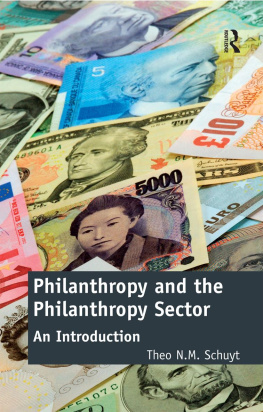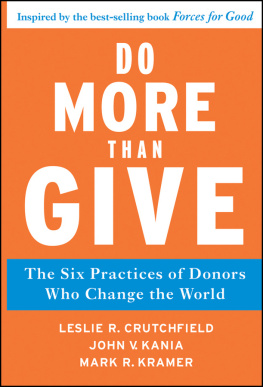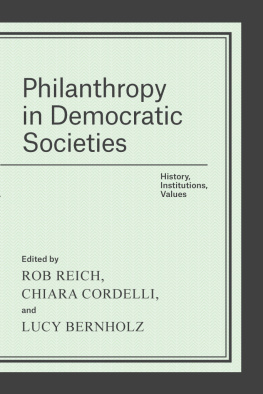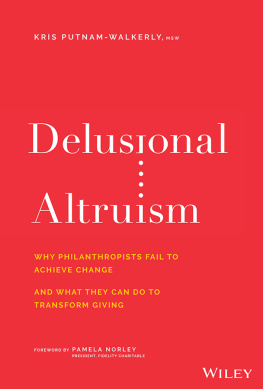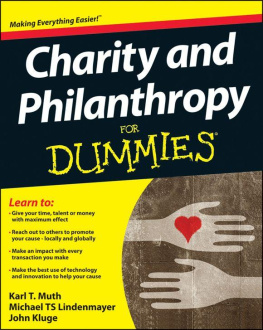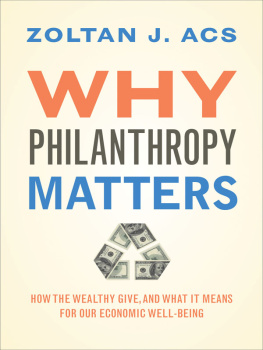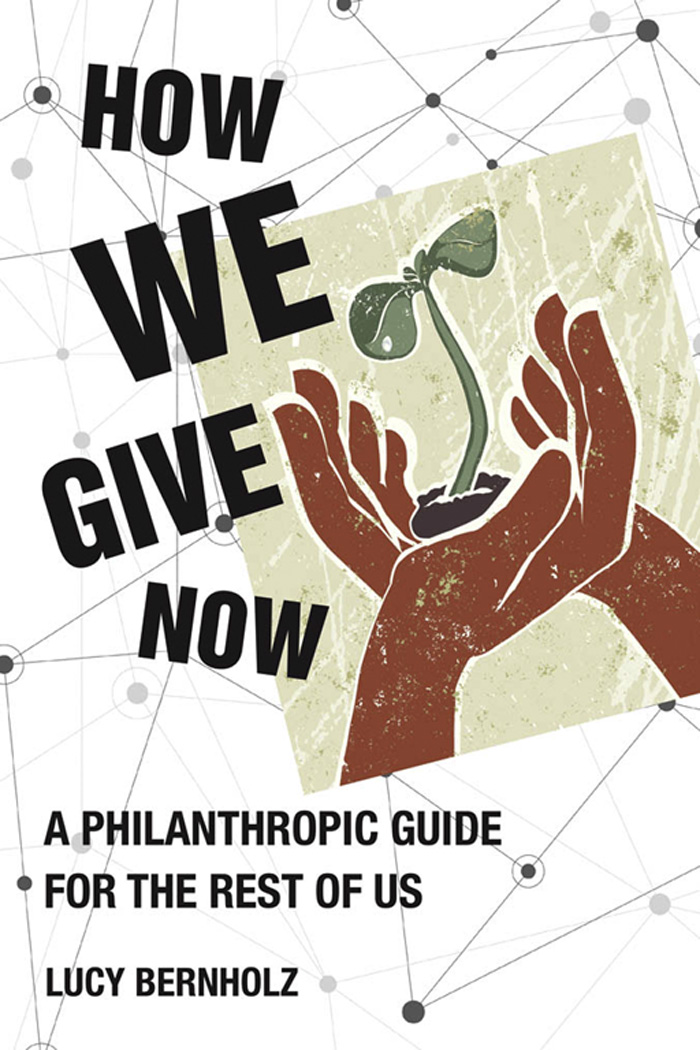
How We Give Now
How We Give Now
A Philanthropic Guide for the Rest of Us
Lucy Bernholz
The MIT Press
Cambridge, Massachusetts
London, England
2021 Massachusetts Institute of Technology
All rights reserved. No part of this book may be reproduced in any form by any electronic or mechanical means (including photocopying, recording, or information storage and retrieval) without permission in writing from the publisher.
This book was set in Adobe Garamond Pro by New Best-set Typesetters Ltd.
Library of Congress Cataloging-in-Publication Data
Names: Bernholz, Lucy, author.
Title: How we give now : a philanthropic guide for the rest of us / Lucy Bernholz.
Description: Cambridge : The MIT Press, 2021. | Includes bibliographical references and index.
Identifiers: LCCN 2020048458 | ISBN 9780262046176 (hardcover)
Subjects: LCSH: EndowmentsUnited States. | CharitiesUnited States. | Generosity. | Nonprofit organizationsUnited StatesHistory.
Classification: LCC HV91 .B396 2021 | DDC 361.7dc23
LC record available at https://lccn.loc.gov/2020048458
10 9 8 7 6 5 4 3 2 1
d_r0
This book is dedicated to Paula and Harry, who give me everything.
Contents
Introduction
No, thank you, I told the oddly solicitous cashier. I didnt want to help cure cancer. Not today.
I took my change and hurried to my doctors appointment on Market Street. The spasms in my neck flared with every step, as had been happening for a week. I handed the receptionist my insurance card, and she handed me a blue-and-yellow-encased iPad that looked like it had been designed for deep-sea divers. Unlike a clipboard stacked with paper forms, the iPad offered no hint of how many pages of questions would follow. I tapped in my name, address, and social security number. Relief and a bit of wonder hit me when the device asked if I wanted to autofill the rest. I clicked Yes, thinking of all the previous appointments when Id spent forever filling out the same forms. I stretched my aching neck and scrolled through decades of my medical history. Finally, the last question: Did I understand that the clinic was part of a teaching hospital and that tissue samples or blood tests taken during my visit might be used for research? As always, I paused at this question. Would they cancel my appointment if I wasnt OK with this? My neck spasmed again. I clicked Yes.
Thirty minutes later, Id seen a doctor, received a referral for physical therapy, and was out the door. Even with digital help, Id spent more time scrolling through my own health information than getting treated.
I stared straight ahead as I walked to the bus stop. The pain in my neck made it hard to avoid eye contact with the red-vested, binder-bearing young man standing directly in my path. Spare a minute to save the planet? Sorry, not today. I kept walking. Oh, cmon, he called, his cheery voice catching the attention of his similarly vested buddy. You can make time for the polar bears, cant you?
No, I wish I could help, but I cant. I guess you hear no a lot? I asked. He ignored this. How about your email address? Can we stay in touch to keep you up to date on the bears?
I scribbled an email address and excused myself. Thats my bus, I said, walking away. I found a seat, dropped my bag, and pulled out my phone. The email Id given him was the one I use just for subscriptions, donations, and purchase receipts. I half-expected to find a note from the polar bear organization already waiting for me.
I scrolled through and deleted dozens of emails, including three requests for money. One was from the development department of my undergraduate college. One was from someone who knows me on LinkedIn and was raising money to help a family whod lost their house in a wildfire. The third was from a nonprofit Id never heard of. It was in the same account I had just scribbled on the red-vested mans clipboard, the one I only use for transactions, meaning a nonprofit Id given to in the past had sold my email. Annoyed, I put away my phone and angled my way off the bus. I grabbed a handful of solicitation envelopes and bills out of my mailbox and went inside. In the time since Id left home, Id been asked for money at the cash register, in my email, and by snail mail. Id been asked for my time, money, and data on the sidewalk. The doctors office hadnt really asked for my data; it felt more like Id been told it was being taken. I still wondered what would have happened had I said no. I put away my coat, collapsed on the couch, and felt like Scrooge.
This is a book about how we use our time, money, and digitized data to make change happen. The focus of this book is on the how of doing this. The how is important for a number of reasons. For more than a century, US law and the media have concentrated their attention on financial donations to charitable nonprofits as the crux of giving. Books, magazines, movies, and radio shows celebrate and criticize wealthy philanthropists, encourage people to become social entrepreneurs, and profile well-intentioned software coders using civic technology to improve government services. These are interesting stories, but they ignore the sort of everyday situation chronicled at the start of this introduction. They also ignore century-old traditions of mutual aid, cooperation, and reciprocity, especially those that thrive in African American, Indigenous, and diasporic communities. They center nonprofits and charitable donations, even though people give much more than money. And, for the most part, the media overhype and the laws ignore our dependence on digital technologies like mobile phones and the internet.
Im aiming for something different with this book. I want to bring people from many races, abilities, ages, and traditions into the center of the conversation to show how we give now: people making daily decisions about how to help others; using all of their resources to lift up their communities; using time, money, and data to advance causes; and people facing a dizzying array of giving choices with no guidance, only sales pitches. Its these people who power change in the world. But its also these people whose choices about giving are ignored and devalued in current legal frameworks and incentive structures. Some of the choices being made by the majority of givers reflect their commitment to help and support others without questioning the broader political context. Others anchor their choices in commitments to collective well-being, or a vision of solidarity and abundance, or approaches that have sustained their communities and cultures for millennia. These visions and practices are legitimate in their own right, even as they are ignored or dismissed by laws, professional practices, and incentives of formal, financialized philanthropy. Recrafting the legal definitions and institutions to reflect and embrace this range of approaches would benefit all who participate. It might even mark a true effort to expand, dare I say democratize, philanthropy.
As in so many other areas of life in the United States, the very wealthy, their advisors, and the industries that serve them have stacked the rules in their favor. This has led to inequitable schools, inadequate public transit, inaccessible health care, unbearable student loan debt, and a lack of the most basic resourceshousing, water, and foodacross the country. The rules about giving are currently written in ways that benefit only the wealthy, even as the vast majority of giving comes from everyday people. Our national laws and stories about philanthropy focus on individuals in ways that are out of sync with the ways we really act, as well as the ways that are most likely to lead to real change. The breadth and diversity of strategies we use to make the world a better place include much more than money, and they depend on connection and reciprocity, whereas the policies, privileges, and products that regulate and shape giving are focused on individual intent, rooted in the financial industry, and ignorant of digital systems. My hope for this book is to expand our understanding of how we give so that we can collectively make more powerful choices, change the laws, and craft a more just and equitable future.
Next page

